Hydrochemical Characteristics, Controlling Factors, and High Nitrate Hazards of Shallow Groundwater in an Urban Area of Southwestern China
Abstract
1. Introduction
2. Study Area
3. Materials and Methods
3.1. Field Sampling and Laboratory Analysis
3.2. Entropy Water Quality Index (EWQI)
4. Results and Discussion
4.1. Hydrochemical Characteristics of Hydrochemical Parameters
4.2. Spatial Distribution Characteristics of Groundwater
4.3. Natural Factors Affecting Groundwater Hydrochemistry
4.4. Anthropogenic Factors Affecting Groundwater Hydrochemistry
4.5. The Impact of Land Use Types on Nitrate Concentrations
4.6. Drinking Water Quality Assessment
5. Conclusions
Author Contributions
Funding
Institutional Review Board Statement
Informed Consent Statement
Data Availability Statement
Conflicts of Interest
References
- Scanlon, B.R.; Fakhreddine, S.; Rateb, A.; De Graaf, I.; Famiglietti, J.; Gleeson, T.; Grafton, R.Q.; Jobbagy, E.; Kebede, S.; Kolusu, S.R.; et al. Author Correction: Global Water Resources and the Role of Groundwater in a Resilient Water Future. Nat. Rev. Earth Environ. 2023, 4, 351. [Google Scholar] [CrossRef]
- Burri, N.M.; Weatherl, R.; Moeck, C.; Schirmer, M. A Review of Threats to Groundwater Quality in the Anthropocene. Sci. Total Environ. 2019, 684, 136–154. [Google Scholar] [CrossRef] [PubMed]
- Wei, D.; Yang, S.; Zou, L.; Torres-Martínez, J.A.; Zheng, Y.; Hu, Q.; Zhang, Y. Appraisal of Potential Toxic Elements Pollution, Sources Apportionment, and Health Risks in Groundwater from a Coastal Area of SE China. J. Environ. Manag. 2025, 377, 124691. [Google Scholar] [CrossRef]
- Sforzi, L.; Sarti, C.; Santini, S.; Martellini, T.; Cincinelli, A. Global Status, Risk Assessment, and Knowledge Gaps of Microplastics in Groundwater: A Bibliometric Analysis. Groundw. Sustain. Dev. 2024, 27, 101375. [Google Scholar] [CrossRef]
- Wick, K.; Heumesser, C.; Schmid, E. Groundwater Nitrate Contamination: Factors and Indicators. J. Environ. Manag. 2012, 111, 178–186. [Google Scholar] [CrossRef] [PubMed]
- Mahvi, A.H.; Nouri, J.; Babaei, A.A.; Nabizadeh, R. Agricultural Activities Impact on Groundwater Nitrate Pollution. Int. J. Environ. Sci. Technol. 2005, 2, 41–47. [Google Scholar] [CrossRef]
- McLay, C.D.A.; Dragten, R.; Sparling, G.; Selvarajah, N. Predicting Groundwater Nitrate Concentrations in a Region of Mixed Agricultural Land Use: A Comparison of Three Approaches. Environ. Pollut. 2001, 115, 191–204. [Google Scholar] [CrossRef]
- Selvam, S.; Nath, A.V.; Roy, P.D.; Jesuraja, K.; Muthukumar, P. Evaluation of Groundwater for Nitrate and Fluoride in Alappuzha Region from the Southwestern Coast of India and Associated Health Risks. Environ. Res. 2023, 236, 116791. [Google Scholar] [CrossRef]
- Zhang, X.; Xu, Z.; Sun, X.; Dong, W.; Ballantine, D. Nitrate in Shallow Groundwater in Typical Agricultural and Forest Ecosystems in China, 2004–2010. J. Environ. Sci. 2013, 25, 1007–1014. [Google Scholar] [CrossRef]
- Bijay-Singh; Craswell, E. Fertilizers and Nitrate Pollution of Surface and Ground Water: An Increasingly Pervasive Global Problem. SN Appl. Sci. 2021, 3, 518. [Google Scholar] [CrossRef]
- Peña-Haro, S.; Llopis-Albert, C.; Pulido-Velazquez, M.; Pulido-Velazquez, D. Fertilizer Standards for Controlling Groundwater Nitrate Pollution from Agriculture: El Salobral-Los Llanos Case Study, Spain. J. Hydrol. 2010, 392, 174–187. [Google Scholar] [CrossRef]
- Singh, B.; Singh, Y.; Sekhon, G.S. Fertilizer-N Use Efficiency and Nitrate Pollution of Groundwater in Developing Countries. J. Contam. Hydrol. 1995, 20, 167–184. [Google Scholar] [CrossRef]
- Chaudhary, I.J.; Chauhan, R.; Kale, S.S.; Gosavi, S.; Rathore, D.; Dwivedi, V.; Singh, S.; Yadav, V.K. Groundwater Nitrate Contamination and Its Effect on Human Health: A Review. Water Conserv. Sci. Eng. 2025, 10, 33. [Google Scholar] [CrossRef]
- Rajan, M.; Karunanidhi, D.; Jaya, J.; Preethi, B.; Subramani, T.; Aravinthasamy, P. A Comprehensive Review on Human Health Hazards Due to Groundwater Contamination: A Global Perspective. Phys. Chem. Earth Parts A/B/C 2024, 135, 103637. [Google Scholar] [CrossRef]
- Karunanidhi, D.; Aravinthasamy, P.; Subramani, T.; Kumar, M. Human Health Risks Associated with Multipath Exposure of Groundwater Nitrate and Environmental Friendly Actions for Quality Improvement and Sustainable Management: A Case Study from Texvalley (Tiruppur Region) of India. Chemosphere 2021, 265, 129083. [Google Scholar] [CrossRef]
- Zhang, Y.; Yan, Y.; Yao, R.; Wei, D.; Huang, X.; Luo, M.; Wei, C.; Chen, S.; Yang, C. Natural Background Levels, Source Apportionment and Health Risks of Potentially Toxic Elements in Groundwater of Highly Urbanized Area. Sci. Total Environ. 2024, 935, 173276. [Google Scholar] [CrossRef]
- Wang, Y.; Li, R.; Wu, X.; Yan, Y.; Wei, C.; Luo, M.; Xiao, Y.; Zhang, Y. Evaluation of Groundwater Quality for Drinking and Irrigation Purposes Using GIS-Based IWQI, EWQI and HHR Model. Water 2023, 15, 2233. [Google Scholar] [CrossRef]
- He, S.; Li, P.; Su, F.; Wang, D.; Ren, X. Identification and Apportionment of Shallow Groundwater Nitrate Pollution in Weining Plain, Northwest China, Using Hydrochemical Indices, Nitrate Stable Isotopes, and the New Bayesian Stable Isotope Mixing Model (MixSIAR). Environ. Pollut. 2022, 298, 118852. [Google Scholar] [CrossRef]
- Liu, J.; Peng, Y.; Li, C.; Gao, Z.; Chen, S. Characterization of the Hydrochemistry of Water Resources of the Weibei Plain, Northern China, as Well as an Assessment of the Risk of High Groundwater Nitrate Levels to Human Health. Environ. Pollut. 2021, 268, 115947. [Google Scholar] [CrossRef]
- Cao, M.; Hu, A.; Gad, M.; Adyari, B.; Qin, D.; Zhang, L.; Sun, Q.; Yu, C.-P. Domestic Wastewater Causes Nitrate Pollution in an Agricultural Watershed, China. Sci. Total Environ. 2022, 823, 153680. [Google Scholar] [CrossRef]
- Zhang, Y.; Li, F.; Zhang, Q.; Li, J.; Liu, Q. Tracing Nitrate Pollution Sources and Transformation in Surface- and Ground-Waters Using Environmental Isotopes. Sci. Total Environ. 2014, 490, 213–222. [Google Scholar] [CrossRef]
- Richa, A.; Touil, S.; Fizir, M. Recent Advances in the Source Identification and Remediation Techniques of Nitrate Contaminated Groundwater: A Review. J. Environ. Manag. 2022, 316, 115265. [Google Scholar] [CrossRef]
- Yang, Q.; Wang, L.; Ma, H.; Yu, K.; Martín, J.D. Hydrochemical Characterization and Pollution Sources Identification of Groundwater in Salawusu Aquifer System of Ordos Basin, China. Environ. Pollut. 2016, 216, 340–349. [Google Scholar] [CrossRef] [PubMed]
- Jin, Z.; Pan, Z.; Jin, M.; Li, F.; Wan, Y.; Gu, B. Determination of Nitrate Contamination Sources Using Isotopic and Chemical Indicators in an Agricultural Region in China. Agric. Ecosyst. Environ. 2012, 155, 78–86. [Google Scholar] [CrossRef]
- Jamshidi, A.; Morovati, M.; Golbini Mofrad, M.M.; Panahandeh, M.; Soleimani, H.; Abdolahpour Alamdari, H. Water Quality Evaluation and Non-Cariogenic Risk Assessment of Exposure to Nitrate in Groundwater Resources of Kamyaran, Iran: Spatial Distribution, Monte-Carlo Simulation, and Sensitivity Analysis. J. Environ. Health Sci. Eng. 2021, 19, 1117–1131. [Google Scholar] [CrossRef] [PubMed]
- Adimalla, N.; Qian, H. Groundwater Quality Evaluation Using Water Quality Index (WQI) for Drinking Purposes and Human Health Risk (HHR) Assessment in an Agricultural Region of Nanganur, South India. Ecotoxicol. Environ. Saf. 2019, 176, 153–161. [Google Scholar] [CrossRef]
- Ram, A.; Tiwari, S.K.; Pandey, H.K.; Chaurasia, A.K.; Singh, S.; Singh, Y.V. Groundwater Quality Assessment Using Water Quality Index (WQI) under GIS Framework. Appl. Water Sci. 2021, 11, 46. [Google Scholar] [CrossRef]
- Xie, Z.; Liu, W.; Chen, S.; Yao, R.; Yang, C.; Zhang, X.; Li, J.; Wang, Y.; Zhang, Y. Machine Learning Approaches to Identify Hydrochemical Processes and Predict Drinking Water Quality for Groundwater Environment in a Metropolis. J. Hydrol. Reg. Stud. 2025, 58, 102227. [Google Scholar] [CrossRef]
- Yao, R.; Zhang, Y.; Yan, Y.; Wu, X.; Uddin, M.G.; Wei, D.; Huang, X.; Tang, L. Natural Background Level, Source Apportionment and Health Risk Assessment of Potentially Toxic Elements in Multi-Layer Aquifers of Arid Area in Northwest China. J. Hazard. Mater. 2024, 479, 135663. [Google Scholar] [CrossRef]
- Su, K.; Wang, Q.; Li, L.; Cao, R.; Xi, Y. Water Quality Assessment of Lugu Lake Based on Nemerow Pollution Index Method. Sci. Rep. 2022, 12, 13613. [Google Scholar] [CrossRef]
- Maskooni, E.; Naseri-Rad, M.; Berndtsson, R.; Nakagawa, K. Use of Heavy Metal Content and Modified Water Quality Index to Assess Groundwater Quality in a Semiarid Area. Water 2020, 12, 1115. [Google Scholar] [CrossRef]
- Sadat-Noori, S.M.; Ebrahimi, K.; Liaghat, A.M. Groundwater Quality Assessment Using the Water Quality Index and GIS in Saveh-Nobaran Aquifer, Iran. Environ. Earth Sci. 2014, 71, 3827–3843. [Google Scholar] [CrossRef]
- Boateng, T.K.; Opoku, F.; Acquaah, S.O.; Akoto, O. Groundwater Quality Assessment Using Statistical Approach and Water Quality Index in Ejisu-Juaben Municipality, Ghana. Environ. Earth Sci. 2016, 75, 489. [Google Scholar] [CrossRef]
- Bouteraa, O.; Mebarki, A.; Bouaicha, F.; Nouaceur, Z.; Laignel, B. Groundwater Quality Assessment Using Multivariate Analysis, Geostatistical Modeling, and Water Quality Index (WQI): A Case of Study in the Boumerzoug-El Khroub Valley of Northeast Algeria. Acta Geochim. 2019, 38, 796–814. [Google Scholar] [CrossRef]
- Kumi; Michael; Anku; Wilson, W.; Antwi; Yeboah, B.; Penny; Govender, P. Evaluation of the Suitability of Integrated Bone Char- and Biochar-Treated Groundwater for Drinking Using Single-Factor, Nemerow, and Heavy Metal Pollution Indexes. Environ. Monit. Assess. 2023, 195, 647. [Google Scholar] [CrossRef]
- Chen, R.-H.; Li, F.-P.; Zhang, H.-P.; Jiang, Y.; Mao, L.-C.; Wu, L.-L.; Chen, L. Comparative Analysis of Water Quality and Toxicity Assessment Methods for Urban Highway Runoff. Sci. Total Environ. 2016, 553, 519–523. [Google Scholar] [CrossRef]
- Deng, J.; Yang, G.; Yan, X.; Du, J.; Tang, Q.; Yu, C.; Pu, S. Quality Evaluation and Health Risk Assessment of Karst Groundwater in Southwest China. Sci. Total Environ. 2024, 946, 174371. [Google Scholar] [CrossRef] [PubMed]
- Rupias, O.J.B.; Pereira, S.Y.; De Abreu, A.E.S. Hydrogeochemistry and Groundwater Quality Assessment Using the Water Quality Index and Heavy-Metal Pollution Index in the Alluvial Plain of Atibaia River- Campinas/SP, Brazil. Groundw. Sustain. Dev. 2021, 15, 100661. [Google Scholar] [CrossRef]
- Abdessamed, D.; Jodar-Abellan, A.; Ghoneim, S.S.M.; Almaliki, A.; Hussein, E.E.; Pardo, M.Á. Groundwater Quality Assessment for Sustainable Human Consumption in Arid Areas Based on GIS and Water Quality Index in the Watershed of Ain Sefra (SW of Algeria). Environ. Earth Sci. 2023, 82, 510. [Google Scholar] [CrossRef]
- Seifi, A.; Dehghani, M.; Singh, V.P. Uncertainty Analysis of Water Quality Index (WQI) for Groundwater Quality Evaluation: Application of Monte-Carlo Method for Weight Allocation. Ecol. Indic. 2020, 117, 106653. [Google Scholar] [CrossRef]
- Cui, H.; Duan, L.; Pan, H.; Liu, T. Geochemical Pattern, Quality and Driving Forces of Multi-Layer Groundwater in a High-Capacity Mining Area Basin: A Comprehensive Analysis Based on the Interweaving of Multiple Factors. J. Hydrol. 2025, 660, 133376. [Google Scholar] [CrossRef]
- Choudhary, S.; Subba Rao, N.; Chaudhary, M.; Das, R. Assessing Sources of Groundwater Quality and Health Risks Using Graphical, Multivariate, and Index Techniques from a Part of Rajasthan, India. Groundw. Sustain. Dev. 2024, 27, 101356. [Google Scholar] [CrossRef]
- Du, J.; Jia, C.; Ding, Y.; Yang, X.; Feng, K.; Wei, M. Advancing Wetland Groundwater Pollution Zoning: A Novel Integration of Monte Carlo Health Risk Modeling and Machine Learning. J. Hazard. Mater. 2025, 494, 138412. [Google Scholar] [CrossRef]
- Dogramaci, S.; Skrzypek, G.; Dodson, W.; Grierson, P.F. Stable Isotope and Hydrochemical Evolution of Groundwater in the Semi-Arid Hamersley Basin of Subtropical Northwest Australia. J. Hydrol. 2012, 475, 281–293. [Google Scholar] [CrossRef]
- Ujević Bošnjak, M.; Capak, K.; Jazbec, A.; Casiot, C.; Sipos, L.; Poljak, V.; Dadić, Ž. Hydrochemical Characterization of Arsenic Contaminated Alluvial Aquifers in Eastern Croatia Using Multivariate Statistical Techniques and Arsenic Risk Assessment. Sci. Total Environ. 2012, 420, 100–110. [Google Scholar] [CrossRef] [PubMed]
- Fu, C.; Li, X.; Ma, J.; Liu, L.; Gao, M.; Bai, Z. A Hydrochemistry and Multi-Isotopic Study of Groundwater Origin and Hydrochemical Evolution in the Middle Reaches of the Kuye River Basin. Appl. Geochem. 2018, 98, 82–93. [Google Scholar] [CrossRef]
- Nath, A.V.; Sekar, S.; Roy, P.D.; Kamaraj, J.; Shukla, S.; Khan, R. Drinking and Irrigation Quality and Pollution Assessments of the Groundwater Resources from Alappuzha in Kerala (India) through an Integrated Approach Using WQI and GIS. J. Geochem. Explor. 2024, 258, 107391. [Google Scholar] [CrossRef]
- Krishan, G.; Kumar, M.; Rao, M.S.; Garg, R.; Yadav, B.K.; Kansal, M.L.; Singh, S.; Bradley, A.; Muste, M.; Sharma, L.M. Integrated Approach for the Investigation of Groundwater Quality through Hydrochemistry and Water Quality Index (WQI). Urban Clim. 2023, 47, 101383. [Google Scholar] [CrossRef]
- Yao, R.; Xu, J.; Zhou, Y.; Li, S.; Su, J.; Yan, Y.; Gan, Y.; Luo, M.; Zhang, Y. Hydrochemical Evolution and Assessment of Groundwater Quality in an Intensively Agricultural Area: Case Study of Chengdu Plain, Southwestern China. Environ. Earth Sci. 2025, 84, 211. [Google Scholar] [CrossRef]
- Ahmed, S.; Haque, K.E.; Moniruzzaman, M.; Suborna, M.A.K.; Anonna, T.; Bhuyian, M.A.Q.; Ahsan, M.A.; Khan, A.H.A.N.; Karim, M.M.; Kasem, M.A. Hydrogeochemistry, Water Quality, and Potential Human Health Risk Assessment of Groundwater in a Drought-Prone Area, Bangladesh. Groundw. Sustain. Dev. 2025, 29, 101450. [Google Scholar] [CrossRef]
- Vesković, J.; Deršek-Timotić, I.; Lučić, M.; Miletić, A.; Đolić, M.; Ražić, S.; Onjia, A. Entropy-Weighted Water Quality Index, Hydrogeochemistry, and Monte Carlo Simulation of Source-Specific Health Risks of Groundwater in the Morava River Plain (Serbia). Mar. Pollut. Bull. 2024, 201, 116277. [Google Scholar] [CrossRef] [PubMed]
- Rajan, S.; Nandimandalam, J.R.; Ram, P. Hydrogeochemical Evolution of Spring Water in the Western Lower Himalayas: Seasonal Changes, Quality Assessment, and Health Risks. Groundw. Sustain. Dev. 2025, 29, 101411. [Google Scholar] [CrossRef]
- Nisar, U.B.; Rehman, W.U.; Saleem, S.; Taufail, K.; Rehman, F.U.; Farooq, M.; Ehsan, S.A. Assessment of Water Quality Using Entropy-Weighted Quality Index, Statistical Methods and Electrical Resistivity Tomography, Moti Village, Northern Pakistan. J. Contam. Hydrol. 2024, 264, 104368. [Google Scholar] [CrossRef] [PubMed]
- Liu, M. Response of Groundwater Chemical Characteristics to Land Use Types and Health Risk Assessment of Nitrate in Semi-Arid Areas: A Case Study of Shuangliao City, Northeast China. Ecotoxicol. Environ. Saf. 2022, 236, 113473. [Google Scholar] [CrossRef]
- Wang, S.; Zheng, W.; Currell, M.; Yang, Y.; Zhao, H.; Lv, M. Relationship between Land-Use and Sources and Fate of Nitrate in Groundwater in a Typical Recharge Area of the North China Plain. Sci. Total Environ. 2017, 609, 607–620. [Google Scholar] [CrossRef] [PubMed]
- Choi, W.-J.; Han, G.-H.; Lee, S.-M.; Lee, G.-T.; Yoon, K.-S.; Choi, S.-M.; Ro, H.-M. Impact of Land-Use Types on Nitrate Concentration and δ15N in Unconfined Groundwater in Rural Areas of Korea. Agric. Ecosyst. Environ. 2007, 120, 259–268. [Google Scholar] [CrossRef]
- Iqbal, J.; Su, C.; Abbas, H.; Jiang, J.; Han, Z.; Baloch, M.Y.J.; Xie, X. Prediction of Nitrate Concentration and the Impact of Land Use Types on Groundwater in the Nansi Lake Basin. J. Hazard. Mater. 2025, 487, 137185. [Google Scholar] [CrossRef]
- Zhang, Y.; Dai, Y.; Wang, Y.; Huang, X.; Xiao, Y.; Pei, Q. Hydrochemistry, Quality and Potential Health Risk Appraisal of Nitrate Enriched Groundwater in the Nanchong Area, Southwestern China. Sci. Total Environ. 2021, 784, 147186. [Google Scholar] [CrossRef]
- Cui, R.; Chen, A.; Hu, W.; Fu, B.; Liu, G.; Zhang, D. Appropriate Stoichiometric Ratios of Dissolved Organic Carbon and Nitrate Can Trigger a Transition in Nitrate Removal in Groundwater around Plateau Lakes, Southwest China. Sci. Total Environ. 2024, 916, 170313. [Google Scholar] [CrossRef]
- Piper, A.M. A Graphic Procedure in the Geochemical Interpretation of Water-Analyses. Eos Trans. Am. Geophys. Union 1944, 25, 914. [Google Scholar] [CrossRef]
- GB/T 14848-2017; Standard for Groundwater Quality. AQSIQ Standards Press of China: Beijing, China, 2017.
- Mao, M.; Wang, X.; Zhu, X. Hydrochemical Characteristics and Pollution Source Apportionment of the Groundwater in the East Foothill of the Taihang Mountains, Hebei Province. Environ. Earth Sci. 2021, 80, 14. [Google Scholar] [CrossRef]
- Gibbs, R.J. Mechanisms Controlling World Water Chemistry. Science 1970, 170, 1088–1090. [Google Scholar] [CrossRef]
- Samtio, M.S.; Hakro, A.A.A.D.; Jahangir, T.M.; Mastoi, A.S.; Lanjwani, M.F.; Rajper, R.H.; Lashari, R.A.; Agheem, M.H.; Noonari, M.W. Impact of Rock-Water Interaction on Hydrogeochemical Characteristics of Groundwater: Using Multivariate Statistical, Water Quality Index and Irrigation Indices of Chachro Sub-District, Thar Desert, Sindh, Pakistan. Groundw. Sustain. Dev. 2023, 20, 100878. [Google Scholar] [CrossRef]
- Liu, Z.; Wang, X.; Wan, X.; Jia, S.; Mao, B. Evolution Origin Analysis and Health Risk Assessment of Groundwater Environment in a Typical Mining Area: Insights from Water-Rock Interaction and Anthropogenic Activities. Environ. Res. 2024, 252, 118792. [Google Scholar] [CrossRef]
- Chowdhury, P.; Mukhopadhyay, B.P.; Bera, A. Hydrochemical Assessment of Groundwater Suitability for Irrigation in the North-Eastern Blocks of Purulia District, India Using GIS and AHP Techniques. Phys. Chem. Earth Parts A/B/C 2022, 126, 103108. [Google Scholar] [CrossRef]
- Adjéï Kouacou, B.; Anornu, G.; Adiaffi, B.; Gibrilla, A. Hydrochemical Characteristics and Sources of Groundwater Pollution in Soubré and Gagnoa Counties, Côte d’Ivoire. Groundw. Sustain. Dev. 2024, 26, 101199. [Google Scholar] [CrossRef]
- Yu, H.; Gui, H.; Zhao, H.; Wang, M.; Li, J.; Fang, H.; Jiang, Y.; Zhang, Y. Hydrochemical Characteristics and Water Quality Evaluation of Shallow Groundwater in Suxian Mining Area, Huaibei Coalfield, China. Int. J. Coal Sci. Technol. 2020, 7, 825–835. [Google Scholar] [CrossRef]
- Wang, S.; Chen, J.; Zhang, S.; Zhang, X.; Chen, D.; Zhou, J. Hydrochemical Evolution Characteristics, Controlling Factors, and High Nitrate Hazards of Shallow Groundwater in a Typical Agricultural Area of Nansi Lake Basin, North China. Environ. Res. 2023, 223, 115430. [Google Scholar] [CrossRef]
- Sheng, D.; Meng, X.; Wen, X.; Wu, J.; Yu, H.; Wu, M.; Zhou, T. Hydrochemical Characteristics, Quality and Health Risk Assessment of Nitrate Enriched Coastal Groundwater in Northern China. J. Clean. Prod. 2023, 403, 136872. [Google Scholar] [CrossRef]
- Subba Rao, N.; Das, R.; Sahoo, H.K.; Gugulothu, S. Hydrochemical Characterization and Water Quality Perspectives for Groundwater Management for Urban Development. Groundw. Sustain. Dev. 2024, 24, 101071. [Google Scholar] [CrossRef]
- Gao, Y.; Qian, H.; Ren, W.; Wang, H.; Liu, F.; Yang, F. Hydrogeochemical Characterization and Quality Assessment of Groundwater Based on Integrated-Weight Water Quality Index in a Concentrated Urban Area. J. Clean. Prod. 2020, 260, 121006. [Google Scholar] [CrossRef]
- Fan, W.; Zhou, J.; Zheng, J.; Guo, Y.; Hu, L.; Shan, R. Hydrochemical Characteristics, Control Factors and Health Risk Assessment of Groundwater in Typical Arid Region Hotan Area, Chinese Xinjiang. Environ. Pollut. 2024, 363, 125301. [Google Scholar] [CrossRef] [PubMed]
- Hao, Q.; Li, Y.; Xiao, Y.; Yang, H.; Zhang, Y.; Wang, L.; Liu, K.; Liu, G.; Wang, J.; Hu, W.; et al. Hydrogeochemical Fingerprint, Driving Forces and Spatial Availability of Groundwater in a Coastal Plain, Southeast China. Urban Clim. 2023, 51, 101611. [Google Scholar] [CrossRef]
- Wang, D.; Li, P.; Yang, N.; Yang, C.; Zhou, Y.; Li, J. Distribution, Sources and Main Controlling Factors of Nitrate in a Typical Intensive Agricultural Region, Northwestern China: Vertical Profile Perspectives. Environ. Res. 2023, 237, 116911. [Google Scholar] [CrossRef]
- Ding, K.; Zhang, Y.; Zhang, H.; Yu, C.; Li, X.; Zhang, M.; Zhang, Z.; Yang, Y. Tracing Nitrate Origins and Transformation Processes in Groundwater of the Hohhot Basin’s Piedmont Strong Runoff Zone through Dual Isotopes and Hydro-Chemical Analysis. Sci. Total Environ. 2024, 919, 170799. [Google Scholar] [CrossRef]
- Zhang, X.; Gao, S.; Wu, Q.; Li, F.; Wu, P.; Wang, Z.; Wu, J.; Zeng, J. Buffer Zone-Based Trace Elements Indicating the Impact of Human Activities on Karst Urban Groundwater. Environ. Res. 2023, 220, 115235. [Google Scholar] [CrossRef]
- Chen, P.; Ma, J.; Yue, X.; Zeng, H.; Wang, C.; Huang, Q.; Zhou, Y.; Zhang, L. Nitrate Dynamics in Deep Soils of the Loess Plateau: Impact of Different Land Use Types. Ecol. Indic. 2025, 175, 113578. [Google Scholar] [CrossRef]

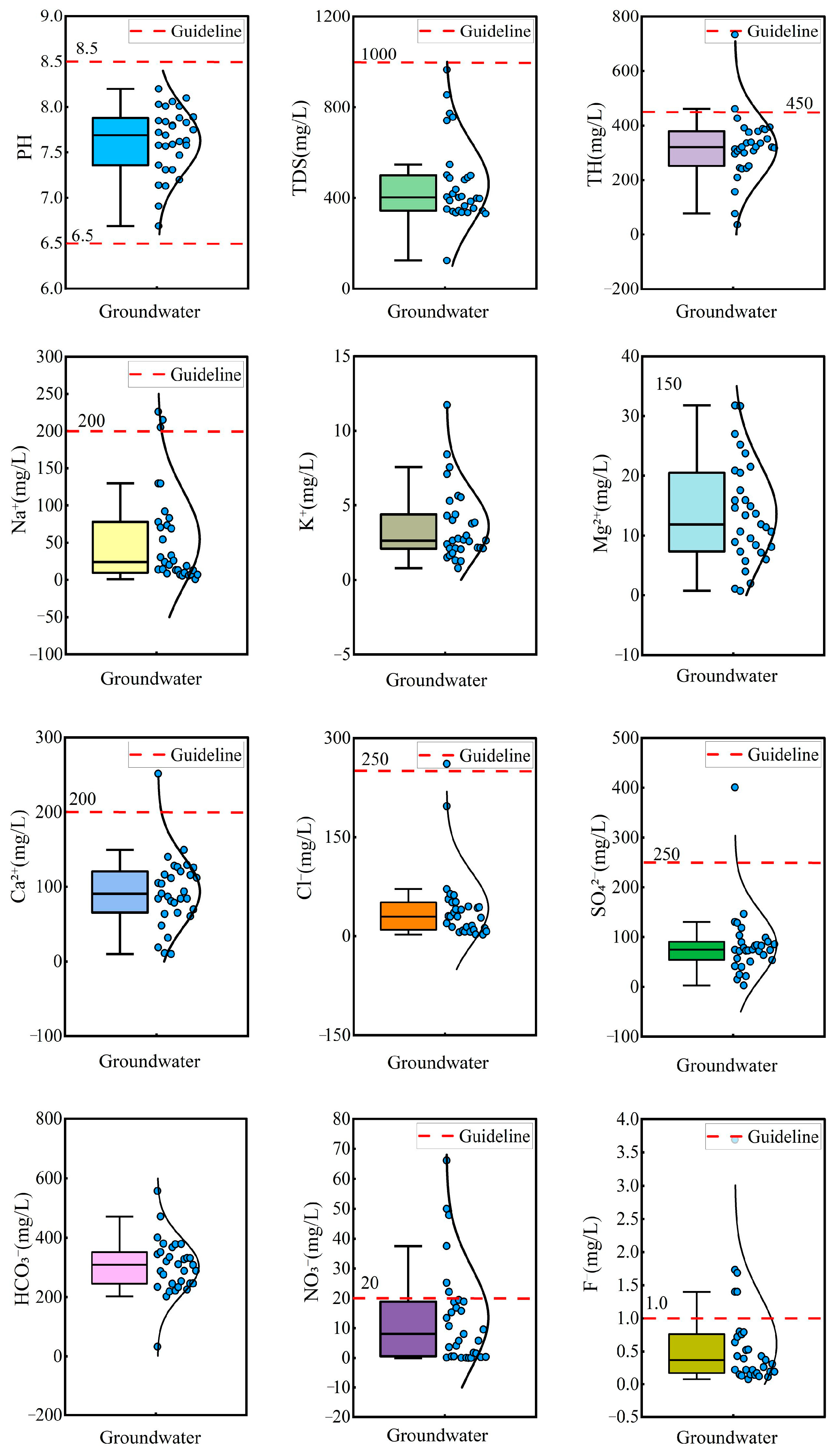

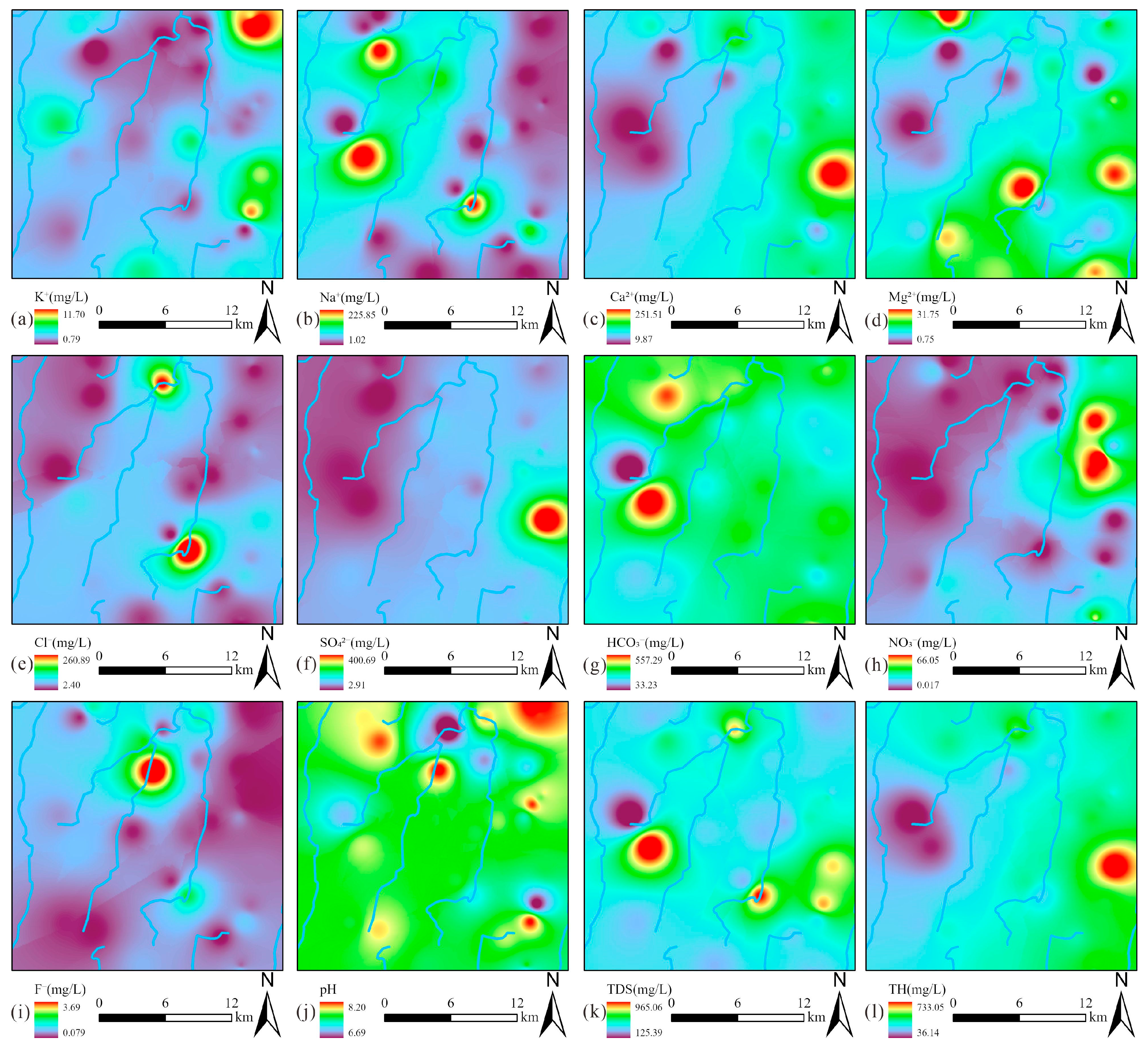
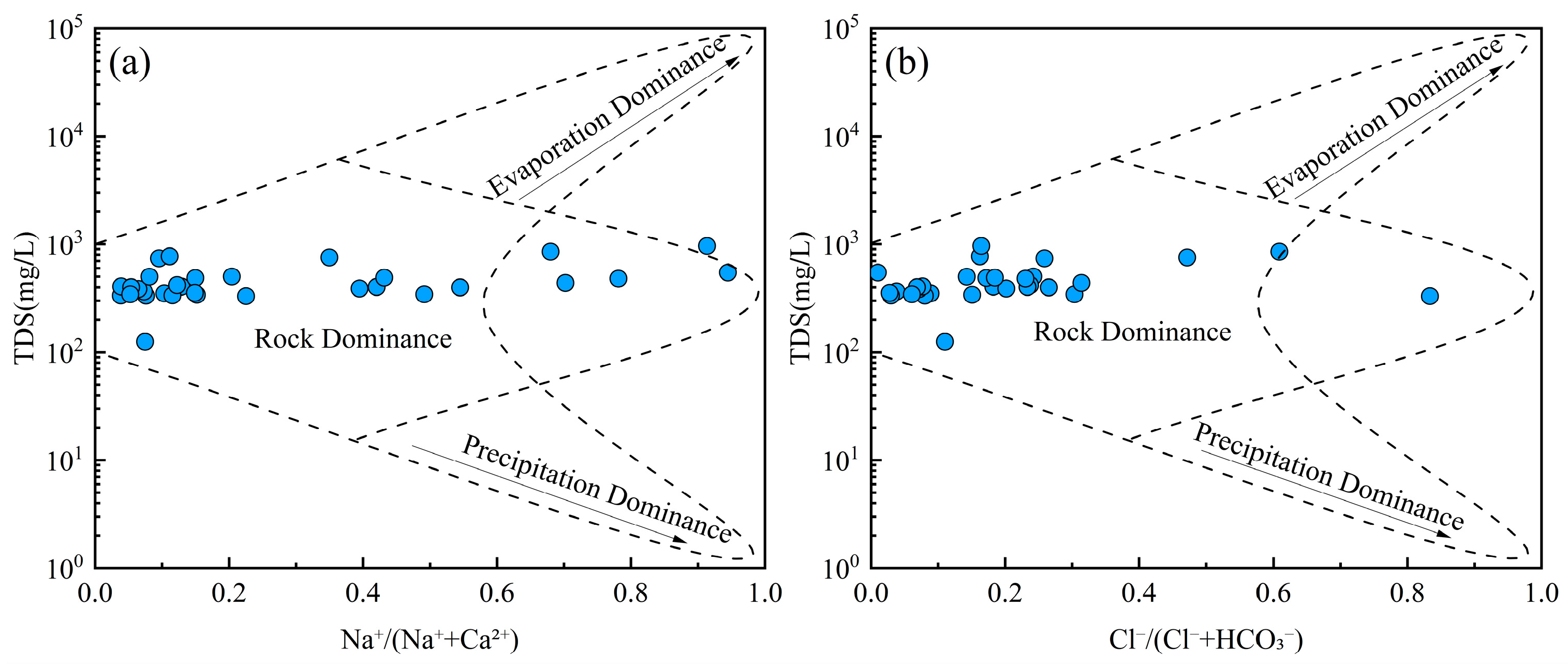


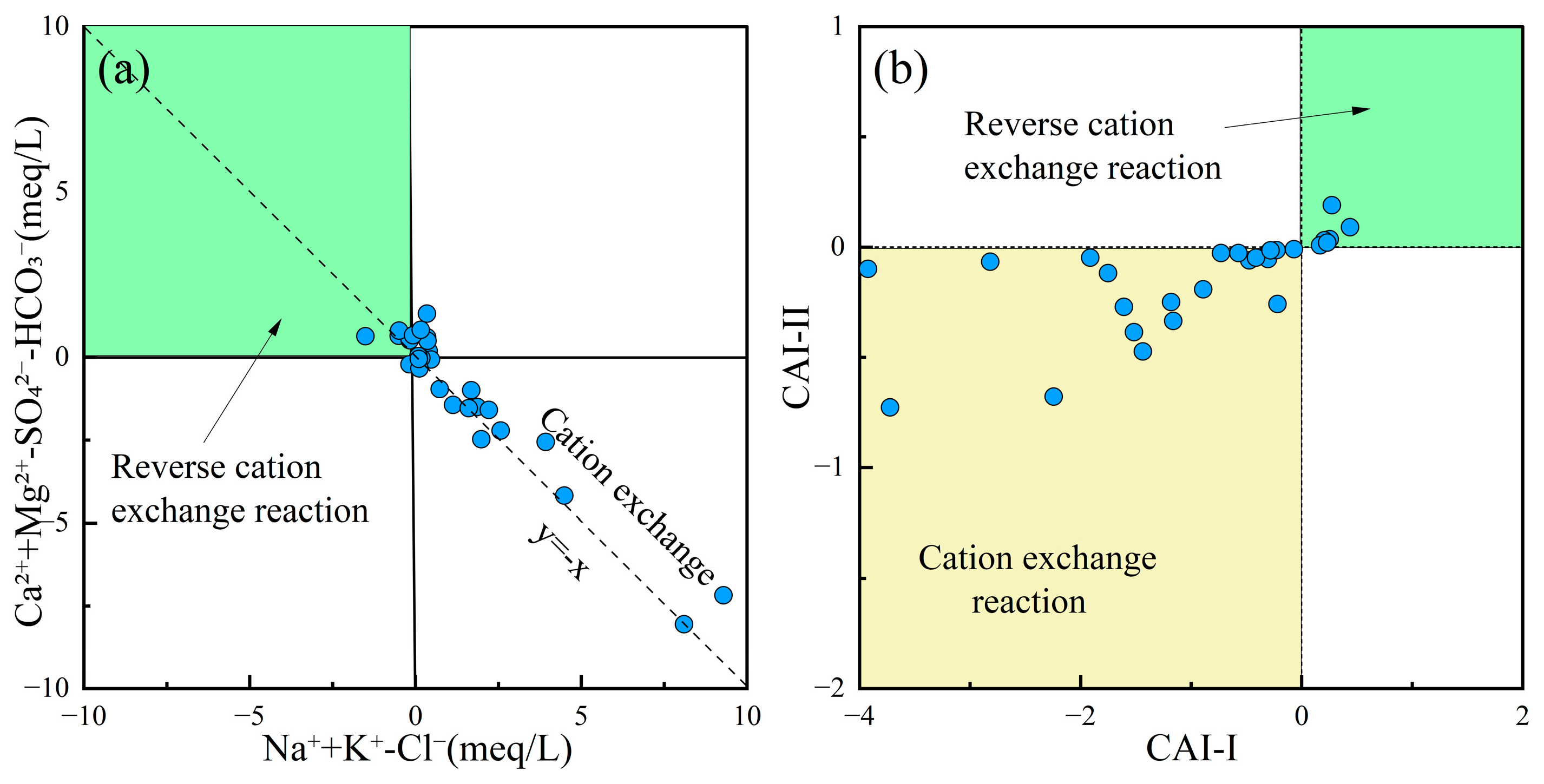
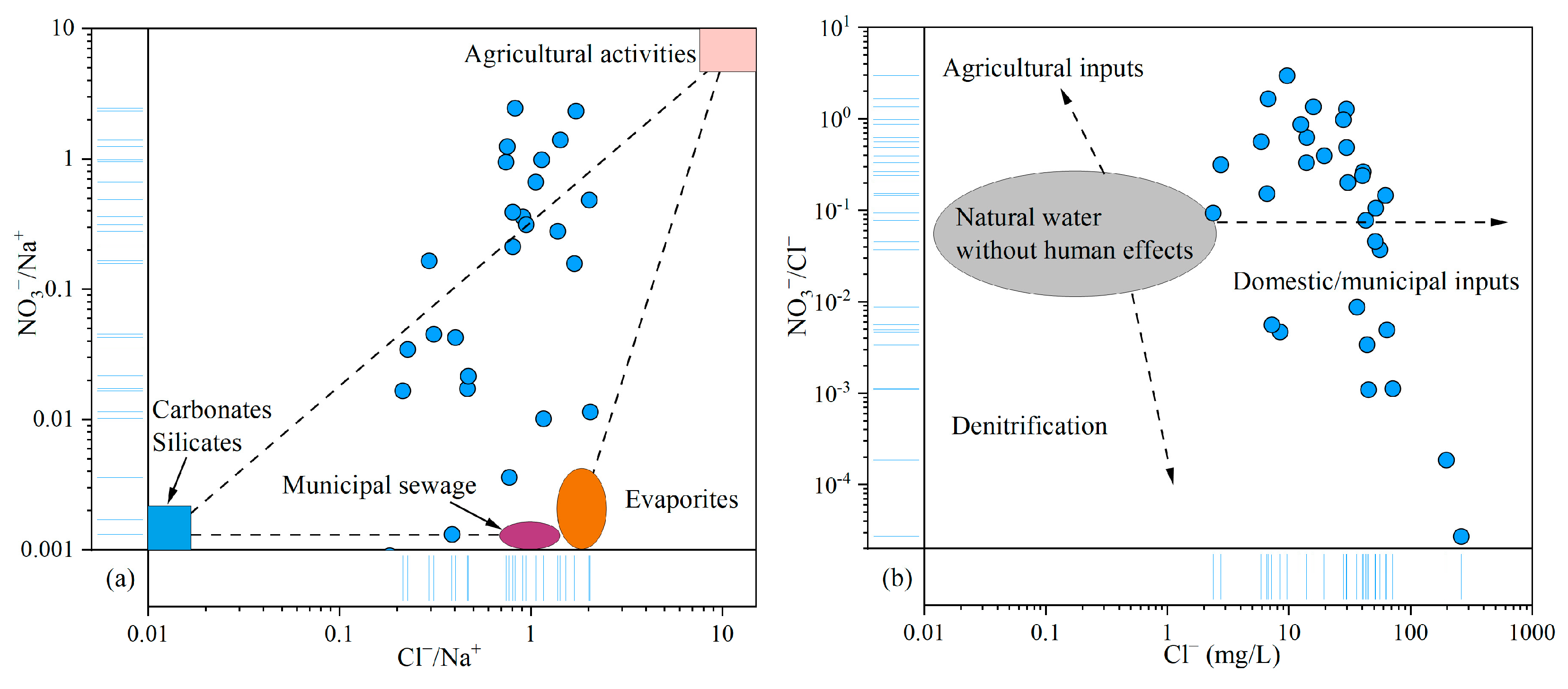
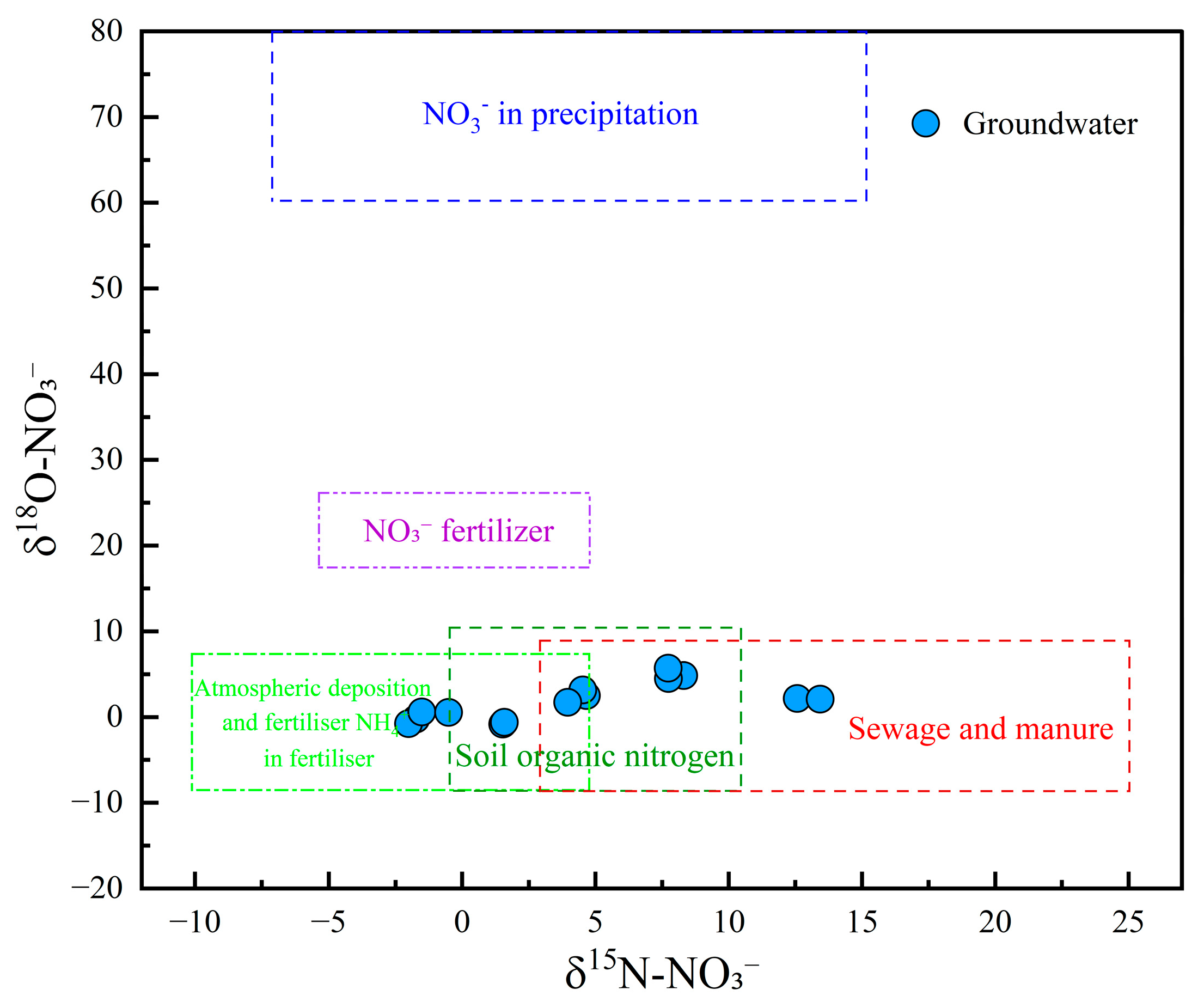
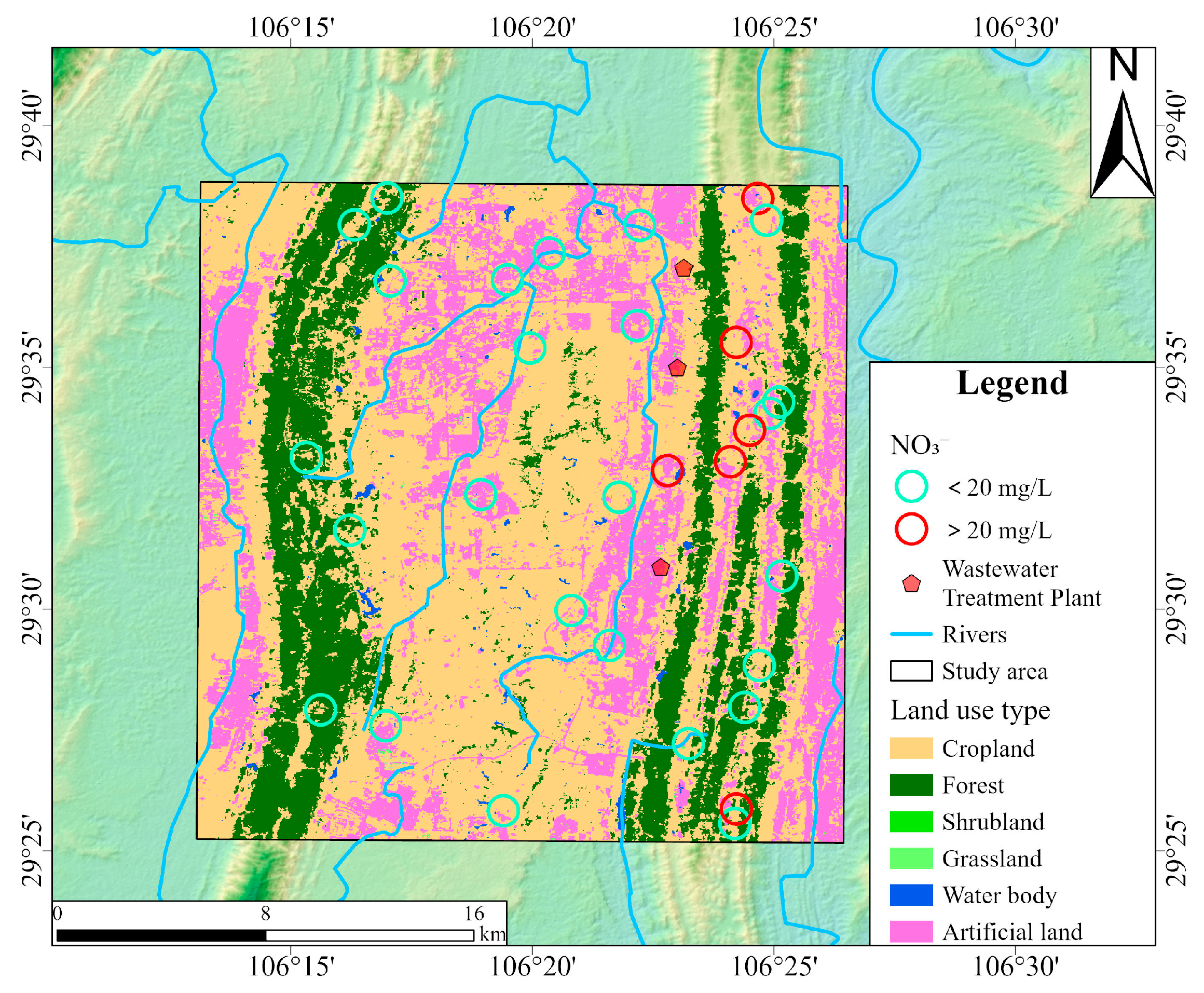
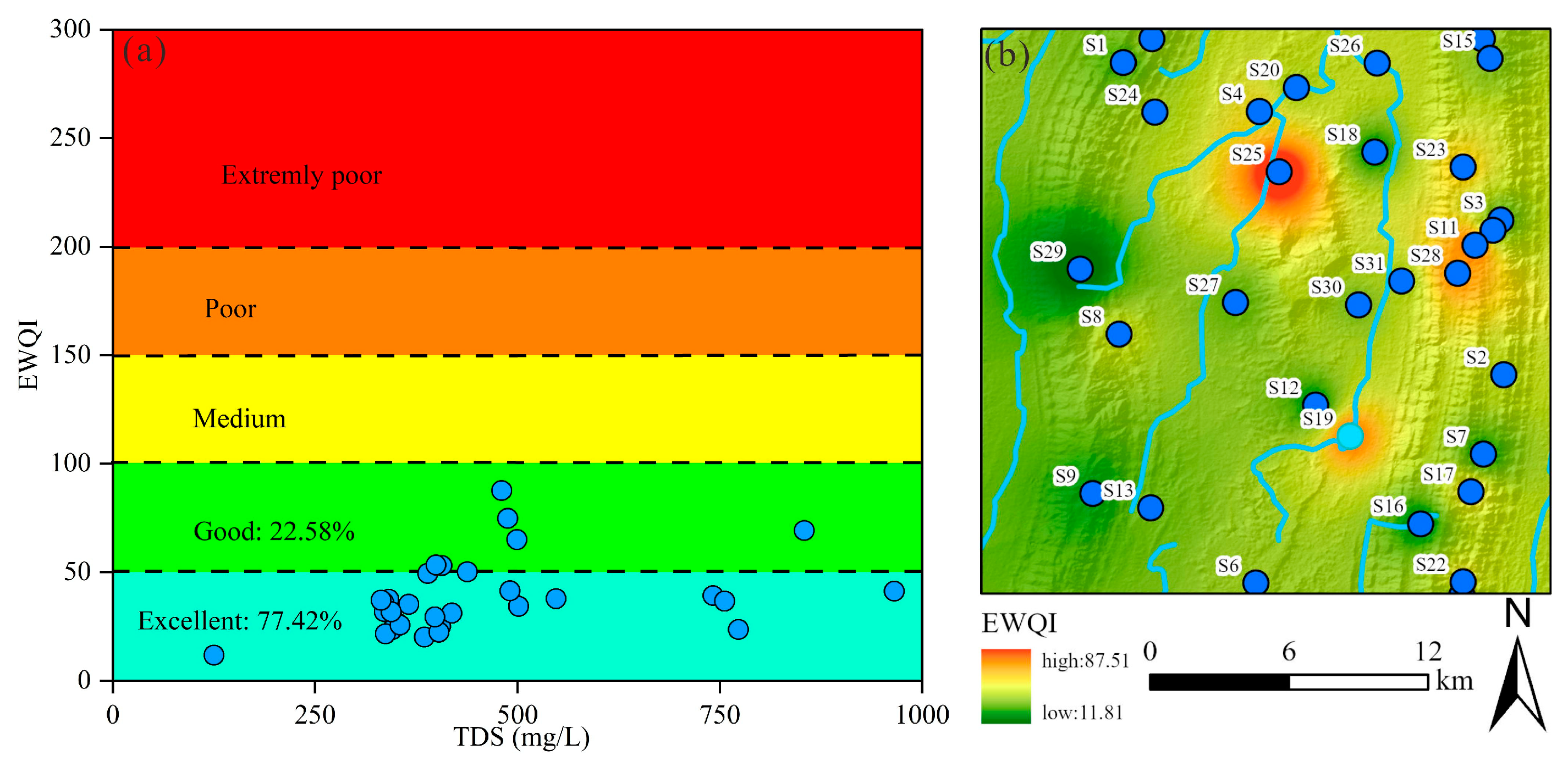
| Parameters | Min | Max | Mean | SD | CV (%) | Limit | % of SEL |
|---|---|---|---|---|---|---|---|
| pH | 6.69 | 8.20 | 7.63 | 0.36 | 5.00 | 6.5–8.5 a | 0 |
| TH | 36.03 | 733.16 | 318.56 | 118.06 | 37.00 | 450 a | 3.22 |
| TDS | 125.00 | 965.55 | 461.54 | 176.54 | 38.00 | 1000 a | 0 |
| K+ | 0.79 | 11.73 | 3.59 | 2.40 | 67.00 | - | - |
| Na+ | 0.91 | 225.98 | 54.73 | 63.74 | 116.00 | 200 a | 3.22 |
| Ca2+ | 9.85 | 251.55 | 93.47 | 46.46 | 50.00 | 400 b | 0 |
| Mg2+ | 0.75 | 31.77 | 13.60 | 8.30 | 61.00 | 50 b | 0 |
| Cl− | 2.37 | 261 | 42.12 | 53.50 | 127.00 | 250 a | 3.22 |
| SO42− | 2.90 | 400.77 | 84.09 | 66.42 | 79.00 | 250 a | 3.22 |
| HCO3− | 32.94 | 557.57 | 303.18 | 91.24 | 30.00 | - | - |
| NO3− | 0.01 | 66.08 | 13.56 | 16.46 | 121.00 | 20 a | 19.35 |
| F− | 0.08 | 3.69 | 0.61 | 0.73 | 119.00 | 1 a | 16.13 |
| Parameters | K+ | Na+ | Ca2+ | Mg2+ | Cl− | SO42− | HCO3− | NO3− | F− | TDS | TH | pH |
|---|---|---|---|---|---|---|---|---|---|---|---|---|
| wj | 0.083 | 0.15 | 0.045 | 0.059 | 0.16 | 0.063 | 0.018 | 0.17 | 0.17 | 0.034 | 0.026 | 0.024 |
Disclaimer/Publisher’s Note: The statements, opinions and data contained in all publications are solely those of the individual author(s) and contributor(s) and not of MDPI and/or the editor(s). MDPI and/or the editor(s) disclaim responsibility for any injury to people or property resulting from any ideas, methods, instructions or products referred to in the content. |
© 2025 by the authors. Licensee MDPI, Basel, Switzerland. This article is an open access article distributed under the terms and conditions of the Creative Commons Attribution (CC BY) license (https://creativecommons.org/licenses/by/4.0/).
Share and Cite
Yang, C.; Chen, S.; Dong, J.; Zhang, Y.; Wang, Y.; Kang, W.; Zhang, X.; Liang, Y.; Fu, D.; Yan, Y.; et al. Hydrochemical Characteristics, Controlling Factors, and High Nitrate Hazards of Shallow Groundwater in an Urban Area of Southwestern China. Toxics 2025, 13, 516. https://doi.org/10.3390/toxics13060516
Yang C, Chen S, Dong J, Zhang Y, Wang Y, Kang W, Zhang X, Liang Y, Fu D, Yan Y, et al. Hydrochemical Characteristics, Controlling Factors, and High Nitrate Hazards of Shallow Groundwater in an Urban Area of Southwestern China. Toxics. 2025; 13(6):516. https://doi.org/10.3390/toxics13060516
Chicago/Turabian StyleYang, Chang, Si Chen, Jianhui Dong, Yunhui Zhang, Yangshuang Wang, Wulue Kang, Xingjun Zhang, Yuanyi Liang, Dunkai Fu, Yuting Yan, and et al. 2025. "Hydrochemical Characteristics, Controlling Factors, and High Nitrate Hazards of Shallow Groundwater in an Urban Area of Southwestern China" Toxics 13, no. 6: 516. https://doi.org/10.3390/toxics13060516
APA StyleYang, C., Chen, S., Dong, J., Zhang, Y., Wang, Y., Kang, W., Zhang, X., Liang, Y., Fu, D., Yan, Y., & Yang, S. (2025). Hydrochemical Characteristics, Controlling Factors, and High Nitrate Hazards of Shallow Groundwater in an Urban Area of Southwestern China. Toxics, 13(6), 516. https://doi.org/10.3390/toxics13060516






